|
|
There are currently no events
|
|
| Call Statistics |
| Month | Calls (2023) | Calls (2024) | Calls (2025) |
| Jan | 15 | 29 | 26 |
| Feb | 31 | 28 | 20 |
| Mar | 28 | 31 | |
| Apr | 33 | 33 | |
| May | 36 | 27 | |
| Jun | 35 | 39 | |
| Jul | 32 | 35 | |
| Aug | 20 | 33 | |
| Sep | 30 | 24 | |
| Oct | 32 | 31 | |
| Nov | 20 | 31 | |
| Dec | 23 | 21 | |
| Total | 335 | 362 | 46 |
| Annual Totals |
| 2014 | 260 |
| 2015 | 252 |
| 2016 | 244 |
| 2017 | 281 |
| 2018 | 319 |
| 2019 | 284 |
| 2020 | 335 |
| 2021 | 285 |
| 2022 | 312 |
| 2023 | 335 |
| 2024 | 362 |
| Web Counters |
Website Visitors
Since
Oct 6, 2008
|
Visitors Today
Jul 03, 2025
|
|
Use of Website Material:
|
| Duplication of text, photos, or any other content on this
website is prohibited without permission of GBFD. If you have questions, please contact our webmaster |


|
|
|
|
|
|
|
|
|
| Important Safety Information | | | | Smoking Related Fires | Candle Safety | | Smoking materials (i.e., cigarettes, cigars, pipes, etc.) are the leading cause of fire deaths in the United States. Roughly one of every four fire deaths in 2001 was attributed to smoking materials. Facts & figures - In 2001, there were an estimated 31,200 smoking-material fires in structures, 830 civilian deaths, 1,770 civilian injuries and $386 million in property damage. Of the fire deaths, 770 occurred in the home.
- In Canada there were 3,800 fires in 1999 associated with smoking materials. These fires caused 120 civilian deaths, 260 civilian injuries and direct property damage of $58 million Canadian ($39 million U.S.).
- The most common material first ignited in home smoking material-related fires was trash, followed by mattresses and bedding and upholstered furniture.
Source: NFPA's The Smoking-Material Fire Problem, November 2004, by John R. Hall, Jr. Safety tips - Encourage smokers to smoke outside.
- Keep smoking materials away from anything that can burn (i.e., mattresses, bedding, upholstered furniture, draperies, etc.).
- Never smoke in bed or when you are drowsy, intoxicated or medicated.
- Use large, deep, non-tip ashtrays to prevent ashes from spilling onto furniture and check them frequently. Do not rest ashtrays on sofas or chairs.
- Completely douse butts and ashes with water before throwing them away as they can smolder in the trash and cause a fire.
- Smoking should not be allowed in a home where oxygen is in use.
- Whenever someone has been smoking in the home, always check on, between and under upholstery and cushions and inside trashcans for butts that may be smoldering.
- When smokers visit your home, ask them to keep smoking materials, lighters and matches with them so young children do not touch them.
- Keep matches and lighters up high, out of children's sight and reach (preferably in a locked cabinet).
- If you smoke, choose fire-safe cigarettes. They are less likely to cause fires.
| 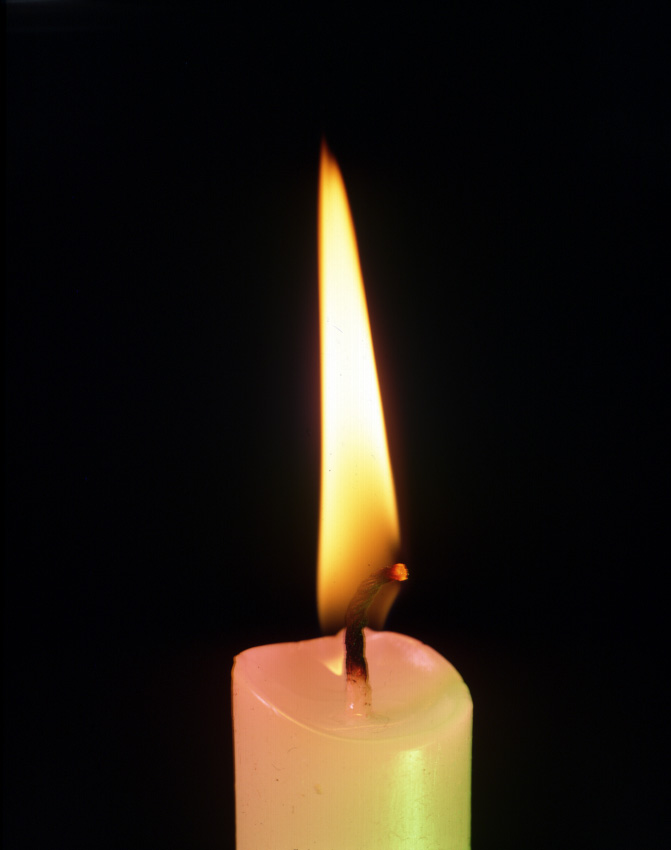 Remember that a candle is an open flame. It can easily ignite any combustible nearby. Facts and figures - During 2002, an estimated 18,000 home fires started by candles were reported to public fire departments. These fires resulted in an estimated 130 civilian deaths, 1,350 civilian injuries and an estimated direct property loss of $333 million. Homes include one- and two-family dwellings, apartments and manufactured housing.
- The estimated number of home candle fires was unchanged from 2001 to 2002. For the first time since 1991, the number of home candle fires has stabilized rather than increasing.
- Candle fires accounted for an estimated 5% of all reported home fires.
- Two-fifths (40%) of the home candle fires started in the bedroom, resulting in 30% of the associated civilian deaths.
- Reported home candle fires have more than tripled since the low of 5,500 in 1990.
- December had almost twice the number of home candle fires of an average month.
- Half (50%) of home candle fires occurred when some form of combustible material was left or came too close to the candle; Eighteen percentoccurred after candles were left unattended, abandoned or inadequately controlled; Five percent were started by people (usually children) playing with the candle.
- Falling asleep was a factor in 12% of home candle fires and 25% of the home candle fire deaths.
- Christmas Day was the peak day of the year for home candle fires in 1999-2002. New Year's Day and Christmas Eve tied for second.
Source: National estimates based on NFIRS and NFPA survey. Safety tips: - Extinguish all candles when leaving the room or going to sleep.
- Keep candles away from items that can catch fire, like clothing, books and curtains.
- Use candle holders that are study, won’t tip over easily, are made from a material that cannot burn, and are large enough to collect dripping wax.
- Keep candles and all open flames away from flammable liquids.
- Keep candle wicks trimmed to one-quarter inch and extinguish taper and pillar candles when they get to within two inches of the holder. Votives and containers should be extinguished before the last half-inch of wax starts to melt.
- During power outages, avoid carrying a lit candle. Use flashlights.
| | | | | Children Playing with Fire | Heater Fires | | 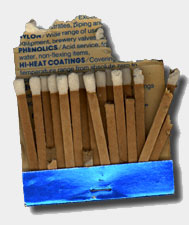
Children playing with fire cause hundreds of deaths and thousands of injuries each year. Preschoolers are most likely to start these fires, typically by playing with matches and lighters, and are most likely to die in them. Facts & figures* - In 2002, children playing with fire started an estimated 13,900 structure fires that were reported to U.S. fire departments, causing an estimated 210 civilian deaths, 1,250 civilian injuries and $339 million in direct property damage.
- The figures for 2002 structure fires, civilian deaths and civilian injuries are the lowest ever recorded.
- Most of the people killed in child-playing fires are under 5, and such fires are the leading cause of fire deaths among preschoolers.
- Roughly two out of every three child-playing fires -- and three out of four associated deaths and injuries -- involve matches or lighters.
- The child-playing fire problem has been smaller, relative to population, in Canada and much smaller in Japan.
- Children also start fires by playing with candles, fireworks, stoves and cigarettes.
- Among fatal home fires started by children playing, seven out of 10 involve children igniting bedding, mattresses, upholstered furniture or clothing.
- Just over half of child-playing fires in the home start in a bedroom.
- Children who start fires may be children in crisis, with the fires acting as cries for help from stressful life experiences or abuse, according to studies of fire-setting behavior.
- As of 2002, deaths in child-playing home structure fires had declined by roughly half since 1994, when the child-resistant lighter standard went into effect.
*From NFPA's Children Playing with Fire, by John R. Hall, Jr., March 2005. Safety tips - Store matches and lighters out of children's reach and sight, up high, preferably in a locked cabinet.
- Never use lighters or matches as a source of amusement for children. They may imitate what you do.
- If your child expresses curiosity about fire or has been playing with fire, calmly but firmly explain that matches and lighters are tools for adults only.
- Use only lighters designed with child-resistant features. Remember child-resistant does not mean child proof.
- Teach young children to tell an adult if they see matches or lighters, and teach school-age children to bring any matches or lighters to an adult.
- Never leave matches or lighters in a bedroom or any place where children may go without supervision.
- If you suspect your child is intentionally setting fires or unduly fascinated with fire, get help. Your local fire department, school, or community counseling agency can put you in touch with trained experts.
| 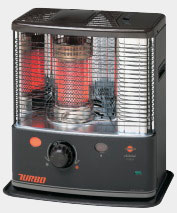 Heating equipment is a leading cause of home fires during the months of December, January and February, and trails only cooking equipment in home fires year-round. Facts & figures - In 2001, an estimated 54,900 home heating equipment fires were reported to U.S. fire departments, resulting in 220 civilian deaths, 1,120 civilian injuries and $502 million in property damage.
- Two of every three home heating fires in the U.S. in 2001, and two of every three related deaths, were attributed to portable and fixed space heaters and related equipment.
- Only 20% of the home heating equipment fires in 2001 began with central heating units.
- Common causes of space heating home fires are: lack of regular cleaning, leading to creosote build-up, in wood-burning devices and associated chimneys and connectors; failing to give space heaters space by installing or placing them too close to combustibles; basic flaws in the construction or design of wood burning heating equipment; fuel spills or leaks involving liquid- or gas-fueled heating equipment.
Source: NFPA's Home Heating Fire Patterns and Trends Safety tips: - When buying a new unit, make sure that a qualified technician installs the unit or checks that the unit has been installed properly.
- For wood or coal stoves or fireplaces, have a professional inspect the chimney, chimney connector and other related equipment every year, and have them cleaned as often as the inspections indicate.
- Keep space heaters at least three feet (or one meter) away from anything that can burn.
- Fuel portable kerosene heaters in a well-ventilated area away from flames or other heat sources, and only when the device has cooled completely. Use only the type of kerosene specified by the manufacturer, and never use gasoline. Use only if such heaters are legal in your community.
- When turning a heating device on or off, follow the manufacturer's instructions. When buying heaters, choose devices with automatic shut-off features.
- Make sure any gas-fueled heating device is adequately ventilated. Unventilated gas space heaters in bedrooms or bathrooms must be small and well-mounted. Never use liquefied-petroleum gas heaters with self-contained fuel supplies in the home.
- Portable space heaters should be turned off every time you leave a room or go to bed.
- Allow ashes to cool before disposing. Dispose ashes in a metal container.
| | | | | Dryer Safety | Electrical Fires | | 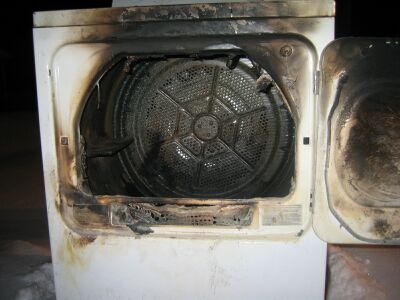
Clothes dryers accounted for the largest share of appliance and tool fires between 1994-1998. Facts & figures - There were 14,300 clothes dryer fires in U.S. homes in 1998, resulting in 19 deaths, 312 injuries and $67.7 million in direct property damage.
- The leading cause of home clothes dryer fires was lack of maintenance (30%), followed by unidentified or unknown-type mechanical failure (11%) and part failure, leak or break (10%).
- Clothing (not on a person) was the most common source of ignition in home clothes dryer fires, followed by dust, fiber or lint.
Source: NFPA's U.S. Home Product Report: Appliances and Equipment Involved in Fires, January 2002. Safety tips - Do not operate the dryer without a lint filter. Clean lint filters before or after each use and remove accumulated lint from around the drum.
- Make sure that the dryer is plugged into an outlet suitable for its electrical needs as overloaded electrical outlets can result in blown fuses or tripped circuit breakers.
- Turn the dryer off when leaving the home.
- Keep the dryer area clear of combustibles (i.e., boxes or clothing).
- Dryers should be installed and serviced by a professional.
- Have gas-powered dryers inspected by a professional regularly to ensure that the gas line and connection are intact.
| 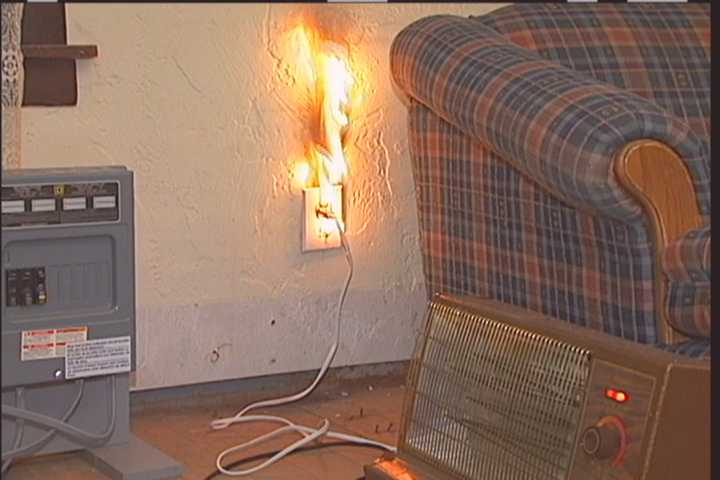
Electrical distribution equipment (i.e., wiring, switches, outlets, cords and plugs, fuse and circuit breaker boxes, lighting fixtures and lamps) was the third leading cause of home fires and the second leading cause of fire deaths in the United States between 1994 and 1998. Facts & figures - There were 38,300 reported home electrical fires in 1998, resulting in 284 deaths, 1,184 injuries and $668.8 million in direct property damage.
- The statistics below are based on annual averages from 1994-98:
- Ground fault or shot circuit was the leading cause of electrical distribution fires.
- Fixed wiring caused one-third of home electrical distribution fires.
- Cords and plugs caused 17% of home electrical distribution fires and 28% of related deaths.
Source: NFPA's U.S. Home Product Report, Appliances and Equipment Involved in Fires, January 2002. Safety tips: | | | | | Fire Safety for the Deaf
or Hard-of-Hearing | Cooking Fires | | 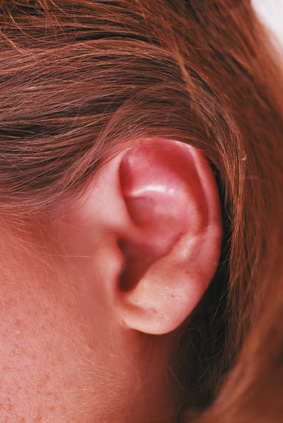 Smoke alarms save lives. But those who are deaf or hard of hearing cannot depend on the sound of the regular alarm to alert them to a fire. There are now a variety of smoke alarms on the market that combine sound and strobe lights to alert those with limited hearing that there is a fire in the home. Facts & figures - Two-fifths of reported home fires occur in the small number of homes with no smoke alarms. As of 2004, 24 of every 25 (96%) U.S. homes with telephones had at least one smoke alarm. However, four of every ten home fires reported to U.S. fire departments still occurred in the now small share of homes without these devices. In one-quarter of reported fires in smoke alarm-equipped homes, the devices didn’t work.
- Smoke alarm failures usually result from missing, disconnected, or dead batteries. When smoke alarms don’t work, it is usually because the batteries are missing, disconnected or dead. People are most likely to remove or disconnect batteries because of nuisance activations. Smoke alarms should be tested every month to ensure the batteries and the units themselves are still working. Replaceable batteries should be replaced in accordance with the manufacturer’s instructions, at least once every year.
Source: NFPA's U.S. Experience With Smoke Alarms and Other Fire Detection/Alarm Equipment report and national estimates reported to U.S. municipal fire departments based on NFIRS and NFPA survey. Safety tips - Consider installing a smoke alarm that uses a flashing light, vibration and/or sound to alert people to a fire emergency. The majority of fatal fires occur when people are sleeping, and because smoke can put people into a deeper sleep, it is important to have the necessary early warning of a fire to ensure that they wake up.
- Be sure that the smoke alarm you buy carries the label of an independent testing laboratory.
- Keep a communications device nearby. If you use a TTY/TTD device, place it close to the bed so that communication with emergency personnel is possible should fire or smoke trap you in your room.
| 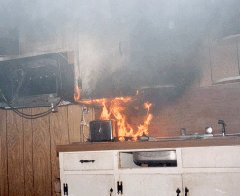
Cooking fires are the #1 cause of home fires and home fire injuries. Most cooking equipment fires start with the ignition of common household items (e.g., food or grease, cabinets, wall coverings, paper or plastic bags, curtains, etc.). Facts & figures* - In 2001, there were 117,100 reported home structure fires associated with cooking equipment, resulting in 370 deaths, 4,290 injuries and $453 million in direct property damage.
- Unattended cooking is the leading cause of home cooking fires.
- Three in every 10 reported home fires start in the kitchen – more than any other place in the home.
- Two out of three reported home cooking fires start with the range or stove.
- Electric ranges or stoves have a higher risk of fires, injuries and property damage, relative to usage, than gas ranges or stoves, but gas ranges or stoves have a higher risk of fire deaths.
*From NFPA's Home Cooking Fire Patterns and Trends, January 2005 Safety tips: - Always use cooking equipment tested and approved by a recognized testing facility.
- Never leave cooking food on the stovetop unattended, and keep a close eye on food cooking inside the oven.
- Keep cooking areas clean and clear of combustibles (e.g. potholders, towels, rags, drapes and food packaging).
- Keep children away from cooking areas by enforcing a “kid-free zone” of three feet (1 meter) around the stove. Keep pets from underfoot so you do not trip while cooking. Also, keep pets off cooking surfaces and nearby countertops to prevent them from knocking things onto burner. Wear short, close fitting or tightly rolled sleeves when cooking. Loose clothing can dangle onto stove burners and catch fire.
- Never use a wet oven mitt, as it presents a scald danger if the moisture in the mitt is heated.
- Always keep a potholder, oven mitt and lid handy. If a small fire starts in a pan on the stove, put on an oven mitt and smother the flames by carefully sliding the lid over the pan. Turn off the burner. Don't remove the lid until it is completely cool. Never pour water on a grease fire and never discharge a fire extinguisher onto a pan fire, as it can spray or shoot burning grease around the kitchen, actually spreading the fire.
- If there is an oven fire, turn off the heat and keep the door closed to prevent flames from burning you and your clothing.
- If there is a microwave fire, keep the door closed and unplug the microwave. Call the fire department and make sure to have the oven serviced before you use it again. Food cooked in a microwave can be dangerously hot. Remove the lids or other coverings from microwaved food carefully to prevent steam burns.
| | | | | Carbon Monoxide Poisoning | Home Fire Escape Planning & Practice | |
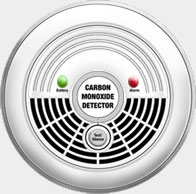 In the past decade, people have become more aware of the risk of carbon monoxide (CO) poisoning in the home. Often called the silent killer, carbon monoxide is an invisible, odorless, colorless gas created when fuels (such as gasoline, wood, coal, natural gas, propane, oil, and methane) burn incompletely. In the home, heating and cooking equipment that burn fuel are potential sources of carbon monoxide. Vehicles or generators running in an attached garage can also produce dangerous levels of carbon monoxide. Facts & figures - According to the National Safety Council, 400 gas-poisoning deaths occurred in 2000, 300 of them in homes.
- The risk of unintentional CO death is highest for the very old (ages 75 or above).
Safety tips - Install CO alarms (listed by an independent testing laboratory) inside your home to provide early warning of accumulating CO.
- CO alarms should be installed in a central location outside each separate sleeping area.
- After purchasing an alarm, call your local fire department's non-emergency telephone number to find out what number to call if the CO alarm sounds. Post that number by your telephone(s) and make sure everyone in the household knows the difference between the fire emergency and CO emergency numbers (if there is a difference).
- Test CO alarms at least once a month, and replace CO alarms according to the manufacturer's instructions.
- If you need to warm a vehicle, remove it from the garage immediately after starting it. Do not run a vehicle, generator, or other fueled engine or motor indoors, even if garage doors are open. Make sure the exhaust pipe of a running vehicle is not covered with snow.
- During and after a snow storm, make sure vents for the dryer, furnace, stove, and fireplace are clear of snow build-up.
- Have fuel-burning household heating equipment (fireplaces, furnaces, water heaters, wood and coal stoves, space or portable heaters) and chimneys inspected by a professional every year before cold weather sets in.
- When using a fireplace, open the flue for adequate ventilation.
- Open a window slightly whenever using a kerosene or gas heater. (Kerosene heaters are illegal in many states. Always check with local authorities before buying or using one.) Only refuel outside, after the device has cooled.
- Never use your oven to heat your home.
- Only use barbecue grills – which can produce CO – outside. Never use them in the home or garage.
- When purchasing new heating and cooking equipment, select products tested and labeled by an independent testing laboratory.
- When purchasing an existing home, have a qualified technician evaluate the integrity of the heating and cooking systems, as well as the sealed spaces between the garage and house.
- When camping, remember to use battery-powered heaters and flashlights in tents trailers, and motor homes.
- CO alarms are not substitutes for smoke alarms. Smoke alarms should be installed on every level of the home and in or outside all sleeping areas.
- Know the difference between the sound of the smoke alarms and the sound of the CO alarms.
If your CO alarm sounds - If it is a battery-powered intermittent alarm, check the battery.
- If it is a steady alarm or you are unable to determine, evacuate the dwelling. Do not re-enter until the responding agency says it is ok.
- Report the CO alarm warning by calling the appropriate phone number.
- Call a qualified technician to inspect all equipment.
Symptoms of CO poisoning - Severe headache, dizziness, mental confusion, nausea, or faintness. Many of these symptoms are similar to the flu, food poisoning or other illnesses.
|

Developing and practicing a home fire escape plan that everyone understands can mean the difference between life and death. Fire can grow and spread through your home very quickly. It's important that you be prepared to react as soon as the smoke alarm sounds. Facts & figures Source: Harris Interactive Survey, Fall 2004, conducted for NFPA (PDF, 759 KB), and NFPA’s Fire Loss in the United States During 2004 - Abridged report (PDF, 89 KB). Safety tips
These tips can help you put together – and practice – an effective home fire escape plan. - Pull together everyone in your household and make a plan. Draw a floor plan of your home (PDF, 107 KB) showing two ways out of each room, including windows. Don't forget to mark the location of each smoke alarm.
- Test all smoke alarms monthly to ensure that they work. Replace batteries as needed.
- Make sure that everyone understands the escape plan and recognizes the sound of the smoke alarm. Are the escape routes clear? Can doors and windows be opened easily?
- If windows or doors in your home have security bars, make sure that the bars have quick- release mechanisms on the inside so that they can be opened immediately in an emergency. Quick-release mechanisms won't compromise your security – but they will increase your chances of safely escaping a home fire.
- Practice the escape plan at least twice a year, making sure that everyone is involved – from kids to grandparents. Allow children to master fire escape planning and practice before holding a fire drill at night when they are sleeping. The objective is to practice, not to frighten, so telling children there will be a drill before they go to bed can be as effective as a surprise drill. If children or others do not readily waken to the sound of the smoke alarm, or if there are infants or family members with mobility limitations, make sure that someone is assigned to assist them in fire drill and in the event of an emergency.
- Agree on an outside meeting place where everyone can meet after they've escaped. Remember to get out first, then call for help. Never go back inside until the fire department gives the OK.
- Have everyone memorize the emergency phone number of the fire department. That way any member of the household can call from a cellular phone or a neighbor's home.
- Be fully prepared for a real fire: when a smoke alarm sounds, get out immediately. And once you're out, stay out – leave the firefighting to the professionals!
- If you live in an apartment building, make sure that you're familiar with the building's evacuation plan. In case of a fire, use the stairs, never the elevator.
- Tell guests or visitors to your home about your family's fire escape plan. When visiting other people's homes, ask about their escape plan. If they don't have a plan in place, offer to help them make one.
|
|
|
|



